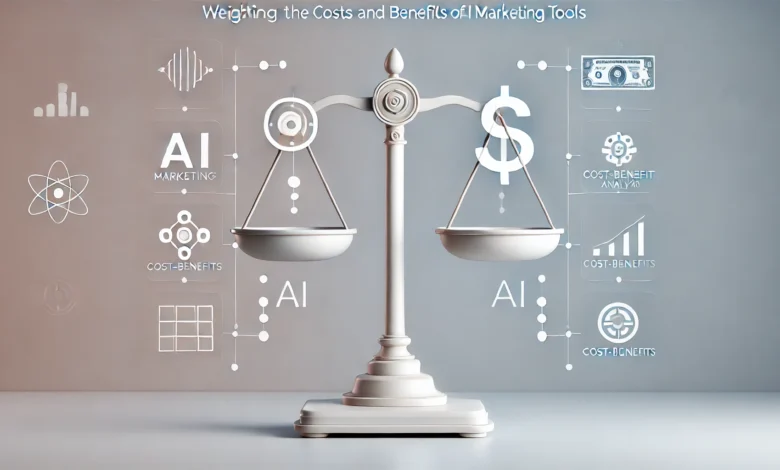The Cost-Benefit Analysis of Using AI Marketing Tools

Imagine unlocking the potential to supercharge your marketing strategy with tools that not only predict trends but also automate and optimize your campaigns in real time. AI marketing tools offer precisely this promise, but before diving headfirst into adoption, it’s crucial to weigh the costs against the benefits.
When considering AI for your marketing efforts, it’s easy to get caught up in the excitement of automation and data-driven insights. However, understanding the financial implications—both immediate and long-term—is essential.
Conducting a thorough cost-benefit analysis ensures that your investment in AI marketing tools leads to measurable improvements in efficiency, customer satisfaction, and ultimately, your bottom line.
Whether you’re a small business looking to gain a competitive edge or a large corporation aiming to maintain your market dominance, the decision to implement AI in your marketing strategy should be informed by a clear understanding of its potential returns.
In this blog, we’ll break down everything you need to know to make a well-informed decision, starting with the costs and benefits associated with these powerful tools.
Cost-Benefit Analysis (CBA) in the Context of AI
Every business decision comes with its own set of risks and rewards, and investing in the AI marketing tool is no different. Cost-benefit analysis (CBA) is a powerful tool that helps businesses evaluate whether the benefits of adopting AI outweigh the costs involved. But what exactly does this mean?
At its core, a CBA involves listing all the potential costs—like initial investments, ongoing maintenance, and training—and comparing them to the expected benefits, such as increased efficiency, higher customer engagement, and improved decision-making.
For AI marketing tools, this could involve calculating the financial savings from automating tasks that were previously manual, or the revenue boost from more accurate targeting of marketing campaigns.
By assigning a monetary value to both costs and benefits, businesses can determine the net gain from AI adoption. The result is a clear picture of whether AI marketing tools will contribute positively to the bottom line, ensuring that any investment is justified and strategically sound.
Costs Associated with Implementing AI Marketing Tools
Implementing AI marketing tools can significantly transform your business, but it’s crucial to understand the associated costs before diving in. These costs can be broadly categorized into direct and indirect expenses, each playing a pivotal role in the overall investment.
1. Direct Costs
The most obvious costs are the direct ones—those that are immediately apparent when you purchase and implement AI tools. These include:
- Software Licensing and Subscription Fees: AI marketing tools often come with subscription models, requiring monthly or annual payments. The cost can vary widely depending on the sophistication of the tool, the number of users, and the level of support provided. High-end tools with advanced features naturally command higher prices.
- Hardware Upgrades: Some AI tools require more processing power or storage than your current systems can handle. This could necessitate investments in new servers, enhanced cloud services, or upgraded workstations to support AI’s computational demands.
- Implementation and Setup Costs: Initial setup costs can be substantial, particularly if the AI tools need to be customized to fit your specific business needs. This could involve hiring external consultants, software developers, or integration specialists to ensure the tool works seamlessly with your existing systems.
2. Indirect Costs
Indirect costs, while less visible, are just as critical to consider. These expenses can accumulate over time and impact your overall ROI.
- Training and Development: Your team will need to learn how to use these new tools effectively. This might require formal training sessions, which come at a cost, or it could involve the time spent by your staff learning the ropes, which can temporarily reduce productivity. Additionally, ongoing education may be needed to keep up with software updates or new AI features.
- Integration with Existing Systems: AI marketing tools must work harmoniously with your current infrastructure. Integrating these tools with your existing CRM, data analytics platforms, and other marketing software can be complex and costly. This might require custom APIs, middleware solutions, or significant adjustments to your current systems.
- Data Privacy and Security: AI tools often rely on large amounts of data to function effectively. Ensuring that this data is handled securely is not just a best practice but a legal requirement in many regions. You may need to invest in enhanced cybersecurity measures, compliance checks, and data governance strategies to protect sensitive information and maintain customer trust.
3. Long-Term Costs
Finally, it’s important to consider the long-term costs associated with AI marketing tools. These are costs that might not be immediately apparent but can affect your financial planning in the long run.
- Ongoing Maintenance and Upgrades: AI tools, like all software, require regular updates to remain effective and secure. Over time, you may also need to upgrade to more advanced versions of the tool, which could involve additional costs.
- Employee Resistance and Change Management: Implementing new technology can sometimes meet resistance from employees who are comfortable with existing processes. Overcoming this resistance might require investments in change management initiatives, including workshops, communication strategies, and incentive programs.
Understanding these costs in detail will help you make a more informed decision about whether AI marketing tools are a wise investment for your business.
Benefits of AI Marketing Tools
Imagine having the power to predict customer behavior, optimize campaigns in real-time, and automate repetitive tasks—all while gaining deeper insights into your market. This is the promise of AI marketing tools, and the benefits they bring can transform your business in ways you might not have thought possible.
1. Efficiency and Automation
One of the most immediate benefits of AI marketing tools is the significant boost in efficiency. AI can automate time-consuming tasks that traditionally require manual input, such as data analysis, customer segmentation, and even content creation. For example, instead of manually sorting through data to identify potential leads, AI can quickly analyze customer behavior and suggest the most promising prospects. This automation not only saves time but also reduces the likelihood of human error, leading to more accurate outcomes and freeing up your team to focus on more strategic initiatives.
2. Enhanced Customer Insights
AI marketing tools provide businesses with unparalleled access to customer insights. By analyzing vast amounts of data—from browsing history to purchasing patterns—AI can help you understand your customers on a deeper level. This means you can create highly personalized marketing campaigns that speak directly to individual preferences, increasing engagement and conversion rates. For instance, AI can predict which products a customer is likely to purchase next or identify the best time to send a marketing email for maximum impact.
3. Improved Decision-Making
AI-driven analytics go beyond simple data collection; they offer actionable insights that can significantly enhance decision-making. By processing data in real-time, AI tools can help you make informed decisions quickly, whether it’s adjusting a campaign based on current performance metrics or pivoting your strategy in response to market changes. This agility is crucial in a competitive landscape, allowing your business to stay ahead of the curve and respond to opportunities as they arise.
4. Scalability
As your business grows, so do the demands on your marketing efforts. AI marketing tools are inherently scalable, meaning they can handle an increasing amount of data and complexity without a corresponding increase in costs. Whether you’re expanding into new markets or launching multiple campaigns simultaneously, AI can scale with your needs, ensuring that your marketing efforts remain efficient and effective, no matter the size of your operation.
5. Competitive Advantage
In a world where data-driven decisions are becoming the norm, leveraging AI marketing tools can give your business a significant competitive edge. Companies that use AI are often able to innovate faster, adapt to market trends more quickly, and deliver personalized customer experiences that set them apart from the competition. This not only helps in retaining existing customers but also in attracting new ones who are looking for brands that understand and cater to their unique needs.
6. Cost Savings
While the initial investment in AI marketing tools can be substantial, the long-term cost savings are often well worth it. By automating tasks that would otherwise require a large team, AI can reduce labor costs. Additionally, by improving targeting and personalization, AI helps to maximize the ROI of your marketing campaigns, ensuring that your budget is spent efficiently and effectively.
Real-World Examples
How do AI marketing tools perform in real-world scenarios? Let’s look at some case studies that highlight their transformative impact across different industries.
1. Small Business Success with AI-Driven Personalization
A small online retailer wanted to enhance its customer engagement and increase sales. They implemented an AI-powered marketing platform that analyzed customer behavior in real-time.
The tool tracked browsing habits, purchase history, and even social media interactions to create personalized product recommendations. As a result, the retailer saw a 20% increase in sales within the first three months and a significant improvement in customer satisfaction.
The AI tool’s ability to tailor marketing messages to individual preferences was a game-changer for this small business, allowing it to compete with larger players in the market.
2. E-commerce Giant Optimizes Ad Spend
A well-known e-commerce platform faced challenges with managing its massive ad budget across various channels. They adopted an AI marketing tool to optimize ad placements and spend in real-time.
The AI system analyzed performance data across different platforms, adjusted bids dynamically, and allocated the budget to the most effective ads. This not only increased their ROI by 30% but also reduced wasteful spending by eliminating underperforming ads.
The company credited the AI tool with helping them achieve better results with less manual effort, allowing their marketing team to focus on strategy rather than execution.
3. B2B Company Enhances Lead Generation
A B2B software company struggled with generating high-quality leads from their digital marketing efforts. They turned to AI for a solution.
By implementing an AI-driven lead scoring system, they could analyze vast amounts of data from website visits, email interactions, and social media engagements to identify the most promising leads.
This AI tool not only improved the accuracy of their lead scoring but also increased conversion rates by 25%.
The marketing team reported that the AI tool helped them focus their efforts on prospects most likely to convert, saving time and resources while boosting sales.
4. Healthcare Provider Improves Patient Outreach
A healthcare provider sought to improve its patient outreach programs, particularly in reminding patients about upcoming appointments and promoting health services.
By using an AI-based communication platform, the provider could send personalized reminders and health tips based on individual patient data. This initiative led to a 15% reduction in missed appointments and a 10% increase in patient engagement with preventive care services.
The AI tool enabled the provider to communicate more effectively with patients, improving overall healthcare outcomes and patient satisfaction.
Challenges and Risks
While AI marketing tools offer numerous benefits, they also come with challenges and risks that businesses need to navigate carefully. Understanding these potential pitfalls can help you implement AI more effectively and avoid common mistakes.
1. High Initial Investment and Ongoing Costs
One of the primary challenges is the high initial cost of adopting AI marketing tools. The expenses don’t stop with the purchase of the software; there are also costs associated with implementation, customization, and ongoing maintenance.
Small and medium-sized businesses, in particular, may find these costs daunting. Moreover, keeping the AI systems up-to-date and integrating them with existing marketing technologies can add to the financial burden.
It’s crucial to conduct a thorough cost-benefit analysis before investing to ensure that the potential returns justify these expenditures.
2. Data Privacy and Security Concerns
AI marketing tools rely heavily on data to function effectively. This reliance on data raises significant privacy and security concerns, especially with the increasing number of regulations like GDPR and CCPA. Businesses must ensure that their AI tools comply with these regulations to avoid legal repercussions.
Additionally, storing and processing large amounts of personal data increases the risk of data breaches, which can damage your reputation and lead to costly penalties. Implementing robust data security measures and staying updated on privacy laws are essential steps to mitigate these risks.
3. Complexity of Integration
Integrating AI tools into existing systems can be a complex and time-consuming process. Many companies struggle with ensuring that AI platforms work seamlessly with their current customer relationship management (CRM) systems, data analytics tools, and marketing automation software.
Poor integration can lead to inefficiencies, data silos, and missed opportunities, ultimately reducing the effectiveness of AI tools.
Businesses may need to invest in specialized IT support or hire external consultants to overcome these integration challenges.
4. Resistance to Change
Another significant challenge is the potential resistance to change within the organization. Employees who are accustomed to traditional marketing methods might be hesitant to adopt AI-driven processes.
This resistance can slow down the implementation of AI tools and limit their effectiveness. To overcome this, businesses need to invest in change management strategies, including training programs, clear communication about the benefits of AI, and involving employees in the transition process to gain their buy-in.
5. Ethical Considerations and Bias
AI systems are only as good as the data they are trained on. If the data used to train AI tools is biased, the AI can produce biased outcomes, leading to unfair or unethical marketing practices.
For example, AI could inadvertently favor certain demographics over others, resulting in discriminatory targeting. Addressing these ethical considerations requires careful monitoring of AI outputs and regularly auditing the data used to train these systems.
Implementing AI responsibly also involves establishing clear guidelines on how AI should be used in marketing campaigns.
6. Uncertainty of ROI
Finally, there’s the challenge of uncertainty regarding the return on investment (ROI). While AI marketing tools have the potential to deliver significant benefits, the results are not always immediate or guaranteed.
Factors such as the quality of the data, the complexity of the implementation, and the skill level of the team can all influence the effectiveness of AI.
Businesses must be prepared for the possibility that it may take time to see a positive ROI and should set realistic expectations for the outcomes.
Best Practices for Conducting a Cost-Benefit Analysis for AI Marketing Tools
Conducting a cost-benefit analysis (CBA) for AI marketing tools is essential for ensuring that your investment delivers real value. This analysis helps you weigh the financial and strategic benefits against the associated costs, guiding you to make informed decisions. Here’s how to approach it effectively:
1. Clearly Define Your Objectives
Before diving into the numbers, it’s crucial to have a clear understanding of what you want to achieve with AI marketing tools. Are you looking to increase customer engagement, improve conversion rates, or reduce operational costs?
Defining specific objectives will help you focus your analysis on the most relevant factors and ensure that the tools you choose align with your business goals.
2. Identify and Quantify Costs
Start by listing all potential costs associated with implementing AI marketing tools. These include direct costs like software licenses, hardware upgrades, and implementation fees, as well as indirect costs such as training, maintenance, and data integration.
Don’t forget to factor in long-term expenses like ongoing subscriptions and updates. Quantifying these costs with as much accuracy as possible will provide a solid foundation for your analysis.
3. Estimate the Expected Benefits
Next, identify the potential benefits of using AI marketing tools and estimate their monetary value. This could include increased revenue from improved targeting, cost savings from automation, or enhanced customer satisfaction leading to higher retention rates.
Be realistic in your projections, considering both short-term gains and long-term strategic advantages. If possible, use case studies or past performance data to inform your estimates.
4. Conduct a Sensitivity Analysis
Sensitivity analysis involves testing how your results change under different assumptions. This is important because the success of AI marketing tools can depend on variables such as market conditions, customer behavior, and technological advancements.
By exploring best-case, worst-case, and most-likely scenarios, you can understand the range of possible outcomes and prepare for uncertainties.
5. Involve Key Stakeholders
Engage stakeholders from various departments, including marketing, IT, finance, and operations. Their input will help ensure that all relevant costs and benefits are considered, and their buy-in will be crucial for successful implementation.
Regularly communicate your findings and involve stakeholders in decision-making to align the AI tool’s deployment with broader business strategies.
6. Monitor and Adjust Post-Implementation
Once the AI marketing tools are implemented, the analysis doesn’t stop. Continuously monitor the performance of these tools against the expected outcomes outlined in your CBA.
This will help you identify any discrepancies and make necessary adjustments. It also provides valuable insights for future investments in AI technologies, allowing you to refine your approach and maximize ROI.
7. Use Decision-Making Frameworks
Finally, consider using decision-making frameworks like the Net Present Value (NPV) or Internal Rate of Return (IRR) to evaluate the financial attractiveness of the investment.
These frameworks can help you compare different investment options and choose the one that offers the best financial return relative to its cost.
Conclusion
Investing in AI marketing tools can be a game-changer for your business, but it’s essential to approach this decision with a clear understanding of both the benefits and the costs.
AI has the potential to automate complex tasks, provide deep customer insights, and significantly enhance your marketing efforts. However, without a thorough cost-benefit analysis, you risk underestimating the financial commitment and overestimating the returns.
By carefully evaluating all aspects—from initial investment and ongoing costs to potential benefits and long-term value—you can make a well-informed decision that aligns with your business goals.
Remember, the key to success with AI lies not just in the technology itself but in how strategically it’s implemented and continuously optimized.
Whether you’re looking to boost efficiency, improve customer engagement, or gain a competitive edge, AI marketing tools offer powerful solutions. With the right approach, they can help you achieve remarkable results and drive your business forward in today’s fast-paced digital landscape.






